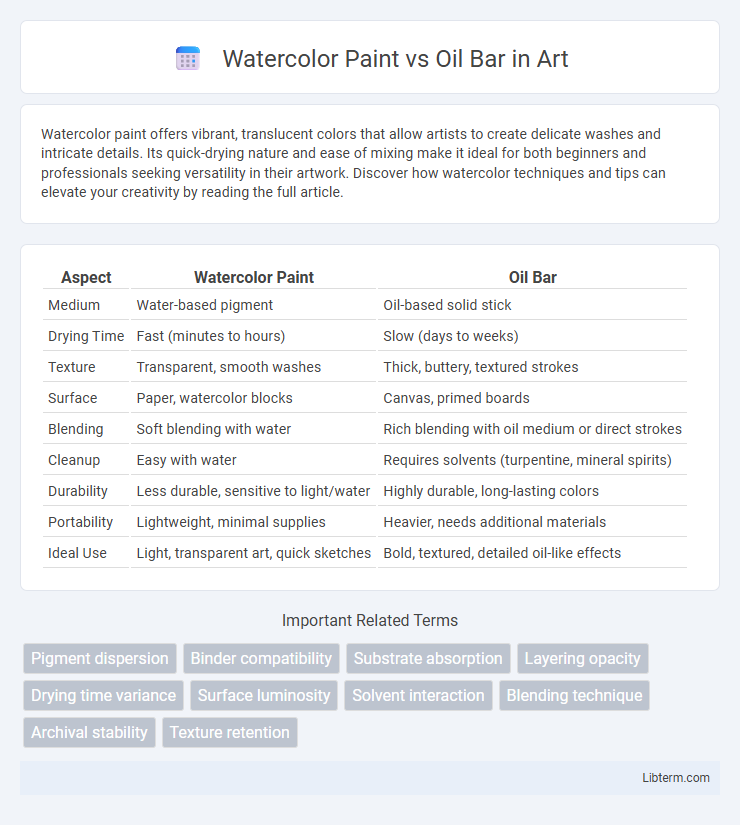Watercolor paint offers vibrant, translucent colors that allow artists to create delicate washes and intricate details. Its quick-drying nature and ease of mixing make it ideal for both beginners and professionals seeking versatility in their artwork. Discover how watercolor techniques and tips can elevate your creativity by reading the full article.
Table of Comparison
| Aspect | Watercolor Paint | Oil Bar |
|---|---|---|
| Medium | Water-based pigment | Oil-based solid stick |
| Drying Time | Fast (minutes to hours) | Slow (days to weeks) |
| Texture | Transparent, smooth washes | Thick, buttery, textured strokes |
| Surface | Paper, watercolor blocks | Canvas, primed boards |
| Blending | Soft blending with water | Rich blending with oil medium or direct strokes |
| Cleanup | Easy with water | Requires solvents (turpentine, mineral spirits) |
| Durability | Less durable, sensitive to light/water | Highly durable, long-lasting colors |
| Portability | Lightweight, minimal supplies | Heavier, needs additional materials |
| Ideal Use | Light, transparent art, quick sketches | Bold, textured, detailed oil-like effects |
Introduction to Watercolor Paint and Oil Bar
Watercolor paint features transparent pigments suspended in a water-soluble binder, offering vibrant washes and delicate layering ideal for fluid, luminous artwork. Oil bars combine traditional oil paints with a solid stick form, allowing direct application of rich, buttery textures and deep, saturated colors without brushes. Both mediums provide unique tactile experiences and distinct visual effects, catering to diverse artistic techniques and styles.
Core Differences: Watercolor vs Oil Bar
Watercolor paint is transparent, water-soluble, and dries quickly, making it ideal for fluid, delicate washes and layering techniques, while oil bars are oil-based, opaque, and dry slowly, allowing for rich texture, blending, and extended working times. Watercolors require paper or a similarly absorbent surface, whereas oil bars work best on primed canvas or board due to their oily consistency. The core difference lies in the medium's drying time, texture, and finish, with watercolors offering luminosity and oils providing depth and tactile quality.
Composition and Ingredients
Watercolor paints primarily consist of pigment suspended in a water-soluble binder, such as gum arabic, allowing for transparency and fluidity in application. Oil bars combine pigment with a drying oil, typically linseed oil, creating a solid, buttery consistency that mimics oil paint but offers the control of a drawing tool. The binder and medium in each significantly influence drying time, texture, and opacity, with watercolors offering light washes and oils providing rich, textured layering.
Application Techniques Compared
Watercolor paint requires layering transparent washes and controlled water flow to create soft gradients and delicate textures, emphasizing fluidity and lightness. Oil bars demand direct, tactile manipulation with impasto strokes and blending on the canvas, enabling thick, textured applications and rich color depth. Both mediums benefit from varied brushwork, but watercolor relies on diluted pigment and wet-on-wet techniques, while oil bars excel with bold, sculptural marks and rapid drying times.
Drying Time and Layering
Watercolor paint dries significantly faster, often within minutes, allowing for rapid layering and adjustments, whereas oil bars require several days to weeks to fully dry due to their oil-based composition. The quick drying time of watercolor enables artists to build transparent, delicate layers efficiently, while oil bars excel at creating rich, textured layers with extended blending opportunities. Understanding these differences is crucial for artists selecting mediums based on project timelines and desired visual effects.
Color Vibrancy and Transparency
Watercolor paint offers exceptional transparency, allowing light to pass through the pigment for luminous, layered effects ideal for delicate washes. Oil bars provide intense color vibrancy with rich, opaque coverage that maintains vivid saturation and texture on various surfaces. Choosing between watercolor and oil bars depends on the desired balance of transparency versus bold, saturated hues in artistic expression.
Surface Compatibility and Preparation
Watercolor paint performs best on highly absorbent surfaces like cold-pressed or rough watercolor paper, which allows for vibrant pigment dispersion and smooth blending. Oil bars require non-absorbent, primed surfaces such as canvas or gesso-coated boards to prevent oil saturation and ensure proper adhesion. Preparing surfaces properly for each medium enhances durability and color intensity, with watercolor demanding clean, textured paper and oil bars benefiting from a sealed, stable foundation.
Longevity and Preservation
Watercolor paint offers a delicate, translucent finish but is more susceptible to fading and damage from humidity over time compared to oil bars. Oil bars provide robust pigment stability and higher resistance to environmental factors, ensuring greater longevity in artworks. Proper sealing and storage techniques are crucial for preserving both mediums, with oil bar pieces generally requiring less frequent conservation efforts.
Ease of Use for Beginners
Watercolor paint offers a straightforward application with easy cleanup, making it ideal for beginners who want to experiment with transparency and layering without extensive preparation. Oil bars, combining oil paint with a stick form, provide a tactile and direct drawing experience but require skill in blending and cleaning with solvents. Beginners typically find watercolor paint more accessible due to its forgiving nature and minimal tools needed.
Choosing the Right Medium for Your Art
Watercolor paint offers transparency and fluidity, ideal for artists seeking delicate washes and subtle color blends, while oil bars provide rich, vibrant pigmentation with a creamy texture that mimics traditional oil painting techniques. Choosing the right medium depends on your desired effect, drying time preference, and surface compatibility, as watercolors work best on paper and oils excel on canvas or primed surfaces. Understanding these differences allows artists to select a medium that aligns with their creative vision and technical needs.
Watercolor Paint Infographic

 libterm.com
libterm.com